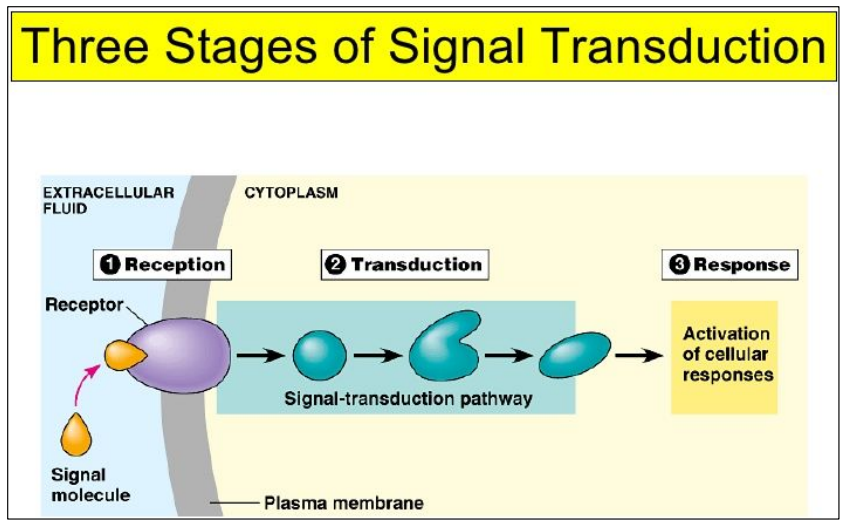- IB DP Biology 2025 SL- IB Style Practice Questions with Answer-Topic Wise-Paper 1
- IB DP Biology 2025 HL- IB Style Practice Questions with Answer-Topic Wise-Paper 1
- IB DP Biology 2025 SL- IB Style Practice Questions with Answer-Topic Wise-Paper 2
- IB DP Biology 2025 HL- IB Style Practice Questions with Answer-Topic Wise-Paper 2
C2.1 Chemical signalling (HL only)
Introduction (HL only)
Cells receive a signal from outside:
Protein receptor’s shape is complementary to the signal molecule = ligand

Stages of cell signalling:
A. Reception
Signaling molecules binds to a receptor protein in the membrane.

B. Transduction
Passing on the signal(can occur in one step , but usually a sequence of changes in a series of “relay molecules”) “transduction pathway”.

C. Response
Cellular changes because of the signal.

Quorum sensing in bacteria (HL only)
Quorum = minimum number of individuals required for an action

Quorum sensing = ability of some bacteria to perceive if they are in sufficient number for an action.
Marine bacterium Vibrio fischeri


Bioluminescent = They produce proteins that emit light only under high density of cells

Lives by itself in ocean
OR
In symbiosis with
Hawaiian bobtail squid (Euprymna scolopes)
Inside the squid’s light organ
Cells secrete molecule = autoinducer
Autoinducer triggers expression of genes
for bioluminescent proteins in cells around .More cells, more autoinducer
More cells
– more autoinducer secreted (LuxI)
– more autoinducer sensed by cells (binds to receptor LuxR)
– bioluminescence genes more expressed (Lux operon genes)
– bioluminescent proteins produced
– bioluminescence

At night, squid from hiding sand to below surface water to feed
Bioluminescence “on”
Predators of squid = fish
Mistakes squid’s light for moonlight
– Squid is safe

Types of signalling chemicals in animals (HL only)
Four types of signalling molecules in animals
- Hormones
- Neurotransmitters
- Cytokines
- Calcium ions
Where do they work in the body?
- Hormones
Endocrine system

- Neurotransmitters
Nervous system

- Cytokines
Immune system

- Calcium ions
All systems
How do they work?
Endocrine and nervous system

Immune system and all systems

- Hormones
Proteins
insulin
glucagon
Steroids
testosterone
oestrogen
Amines
adrenaline
thyroxine
- Neurotransmitters
Amino acids
glutamic acid
aspartic acid
Peptides
vasopressin
oxytocin
Amines
dopamine, acetylcholine, norepinephrine
Nitrous oxide
\(N_2O\)
- Cytokines
Proteins
interleukins
interferons
- Calcium ions
\(Ca^{2+}\)
Receptors and initiation of signal transduction (HL only)
Two types of receptors in animals
- Intracellular
- Transmembrane

Distribution of hydrophilic and hydrophobic amino acids depends on localisation of these receptors

Transmembrane receptors
1. Acetylcholine receptor
In membrane of striated muscle cells
Receive nerve impulse from motor neuron
Response = contraction of muscle cell



2. Adrenaline (epinephrine) receptor
In membrane of cardiac muscle cells
Receive adrenaline from blood
Response = heart beat increase


G-protein = intracellular, peripheral protein
Second messenger = cyclic AMP aka cAMP

NOS: Students should be aware that naming conventions are an example of international
cooperation in science for mutual benefit.
Both “adrenaline” and “epinephrine” were coined by researchers and are based on
production of the hormone by the adrenal gland;
“adrenaline” comes from Latin ad = at and ren = kidney
and “epinephrine” comes from old Greek epi = above and nephros = kidney, respectively.
Unusually, these two terms persist in common use in different parts of the world

3. Insulin receptor
Small intestine cell membrane
Receive insulin from blood
Response = glucose channel moved from cytoplasm to cell membrane
– Glucose enters villus cells


Tyrosine-kinase = enzyme that transfers phosphate to
a tyrosine in other proteins
Absence of insulin: Glucose transporter kept in vesicles in cytoplasm
Presence of insulin: Exocytosis of these vesicles
Intracellular receptors

Steroid hormones receptors
Oestradiol
Progesterone
Testosterone
In cytoplasm of various types of cells
Binds steroid hormone from blood
Complex hormone-receptor into nucleus
Activates transcription of specific genes
Production of specific proteins
Response specific to the hormone
- Oestradiol

1) In cytoplasm of hypothalamus cells
Binds oestradiol hormone from blood
Complex hormone-receptor into nucleus
Activates transcription of specific genes
Production of specific proteins
2) Response = production of Gonadotropin-releasing hormone in hypothalamus
3) Production of FSH and LH hormones in pituitary gland
4) More production of oestradiol in ovaries
– Back to 1)
Positive feedback (amplification)
- Progesterone

1) In cytoplasm of endometrium cells
Binds progesterone hormone from blood
Complex hormone-receptor into nucleus
Activates transcription of specific genes
Production of specific proteins
2) Response in endometrium
Maintains endometrium thick
Increases blood vessels in endometrium
– Prepares uterus for implantation of embryo
3) Response in ovaries
Inhibits secretion of FSH
– Inhibit next ovulation
Negative feedback (reduction)
Positive and negative feedback (HL only)

